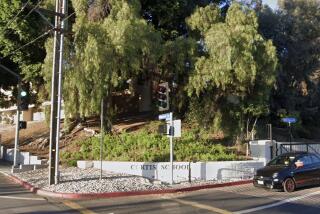The on-campus effect of off-campus threats
Before the advent of the Internet, it made sense for schools to discipline students only for what they said and did when they were on school property. But it’s now possible for a student to disrupt the learning environment by pecking out threats on his home computer or on the telephone he carries on the school bus. Should administrators be able to hold students accountable for misbehavior on this virtual campus?
We think so, and so does the U.S. 9th Circuit Court of Appeals. The court ruled last week that public schools may punish conduct that poses a risk of substantial disruption even if the conduct takes place off school property. The ruling upheld the 90-day expulsion imposed on a high school student in Minden, Nev., who used MySpace to send instant messages that threatened classmates and mentioned the 2007 massacre at Virginia Tech.
Landon Wynar argued that his temporary expulsion from Douglas High School violated both his free-speech rights and his constitutional right to due process. In a landmark 1969 case, the Supreme Court rightly ruled that students don’t “shed their constitutional rights to freedom of speech or expression at the schoolhouse gate.” But that same decision allowed administrators to sanction student expression that was reasonably likely to create “substantial disruption of or material interference with school activities” or violate “the rights of other students to be secure and to be let alone.”
It’s an understatement to say that Wynar’s messages satisfied that legal test. He wrote that “its pretty simple / I have a sweet gun / my neighbor is giving me 500 rounds … I’ve watched these kinds of movies so I know how NOT to go wrong.” He indicated that he would “only kill the people I hate” including “the blacks / and mexicans / halfbreeds / atheists / french / gays / liberals.” (Wynar told school officials the messages were jokes.)
The more difficult question for the court was whether school administrators could punish Wynar for messages he typed at his home. Acknowledging that some federal judges have expressed a different opinion, Judge M. Margaret McKeown concluded that “when faced with an identifiable threat of school violence, schools may take disciplinary action in response to off-campus speech expression” consistent with rules announced by the Supreme Court.
That’s a sensible conclusion. Students do have free-speech rights, even in the classroom, and the courts are right to intervene when administrators overreact to a student’s exercise of that right, whether it’s an antiwar black armband, a T-shirt opposing gay marriage or a “boobie bracelet” worn to express solidarity with breast cancer patients. But when a student seems to target vulnerable classmates, nothing in the Constitution prevents administrators from taking action, whether he tapped out his message in a school computer lab or in the solitude of his bedroom.
More to Read
A cure for the common opinion
Get thought-provoking perspectives with our weekly newsletter.
You may occasionally receive promotional content from the Los Angeles Times.









